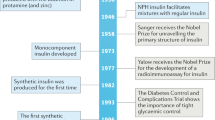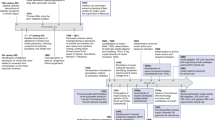Summary
The hypoglycemic activities of NPH biosynthetic human and pork insulins were compared in eight insulin-dependent diabetic patients using continuous blood glucose monitoring. After an overnight normalization of blood glucose levels, either human or pork NPH were injected subcutaneously in random order. Blood glucose was continuously recorded during 9.5 h while patients were consuming their usual diet. After NPH biosynthetic human insulin, blood glucose levels from the 2nd to the 9th h post-injection were lower as well as the glycemic nadir. The area under the curve was smaller after human than after pork insulin. But, in the last half-hour of the experiment, blood glucose was falling after pork insulin, while it was rising after human insulin. Under the conditions of this study, our results demonstrate that NPH biosynthetic human insulin may be more effective than NPH pork insulin, due to more rapid subcutaneous absorption but its duration is shorter than after porcine NPH insulin. These data may be of importance in the treatment of insulin-dependent diabetes mellitus.
Similar content being viewed by others
References
Bottermann P., Gyaram H., Wahl K., Ermler R., Lebender A.: Insulin concentrations and time-action profiles of three different intermediate-acting insulin preparations in nondiabetic volunteers under glucose-controlled insulin infusion technique — Diabetes Care 5 (Suppl. 2), 43, 1982.
Chance R. E., Kroeff E. P., Hoffmann J. A., Frank B. H.: Chemical, physical, and biologic properties of biosynthetic human insulin — Diabetes Care4, 147, 1981.
Christiansen Aa. H.: Radioimmunoelectrophoresis in the determination of insulin binding to IgG. Methodological studies — Hormone metab. Res.5, 147, 1973.
Clark A. J. L., Adeniyi-Jones R. O., Knight G., Leiper J. M., Wiles P. G., Jones R. H., Keen H., Mac Cuish A. C., Ward J. D., Watkins P. J., Cauldwell J. M., Glynne A., Scotton J. B.: Biosynthetic human insulin in the treatment of diabetes. A double-blind crossover trial in established diabetic patients — Lancetii, 354, 1982.
Galloway J. A., Root M. A., Bergstrom R., Spradlin C. T., Howey D. C., Fineberg S. E., Jackson R. L.: Clinical pharmacologic studies with human insulin (recombinant DNA) — Diabetes Care 5 (Suppl. 2): 13, 1982.
Galloway J. A., Spradlin C. T., Root M. A., Fineberg S. E.: The plasma glucose response of normal fasting subjects to neutral regular and NPH biosynthetic human and purified pork insulins — Diabetes Care4, 183, 1981.
Keen H., Glynne A., Pickup J. C., Viberti G. C., Bilous R. W., Jarrett R. J., Marsden R.: Human insulin produced by recombinant DNA technology: safety and hypoglycaemic potency in healthy man — Lancetii, 398, 1980.
Klier M., Kerner W., Torres A. A., Pfeiffer E. F.: Comparison of the biologic activity of biosynthetic human insulin and pork insulin in juvenile onset diabetic subjects assessed by the glucose controlled insulin infusion system — Diabetes Care4, 193, 1981.
Marre M., Tabbi-Anneni A., Tabbi-Anneni H., Assan R.: Comparative study of NPH human insulin (recombinant DNA) and NPH bovine insulin in diabetic subjects — Diabetes Care 5 (Suppl. 2), 63, 1982.
Massi-Benedetti M., Burrin J. M., Capaldo B., Alberti K. G. M. M.: A comparative study of the activity of biosynthetic human insulin and pork insulin using the glucose clamp technique in normal subjects — Diabetes Care4, 163, 1981.
Mirouze J., Collard F., Selam J. L., Pham T. C. J.: Continuous blood glucose monitoring in insulin-treated diabetes. In:Kruse-Jarres J. D., Molnar G. D. (Eds): Blood glucose monitoring. Georg Thieme Verlag, Stuttgart, 1977; Hormone metab. Res.7 (Suppl.), 77, 1977.
Mirouze J., Nonnier L., Richard J. L., Gancel A., Soua K. B.: Comparative study of NPH human insulin (recombinant DNA) and pork insulin in diabetic subjects: preliminary report — Diabetes Care5 (Suppl. 2), 60, 1982.
Mirouze J., Selam J. L., Pham T. C., Cavadore D.: Evaluation of exogenous insulin homeostasis by the artificial pancreas in insulin-dependent diabetes — Diabetologia13, 273, 1977.
Raptis S., Karaiskos C., Enzmann F., Hatzidakis D., Zoupas C., Souvatzoglou A., Diamantopoulos E., Moulopoulos S.: Biologic activities of biosynthetic human insulin in healthy volunteers and insulin-dependent diabetic patients monitored by the artificial endocrine pancreas — Diabetes Care4, 155, 1981.
Viberti G. C., Pickup J. C., Keen H., Bilous R. W., Mattock M., Jarrett R. J., Glynne A., Rogers R.: Biosynthetic human insulin: effect in healthy men on plasma glucose and non-esterified fatty acids in comparison with highly purified pork insulin — Diabetes Care4, 175, 1981.
Author information
Authors and Affiliations
Rights and permissions
About this article
Cite this article
Richard, JL., Rodier, M., Cavalié, G. et al. Human (recombinant DNA) and porcine NPH insulins are unequally effective in diabetic patients. A comparative study using continuous blood glucose monitoring. Acta diabet. lat 21, 211–217 (1984). https://doi.org/10.1007/BF02642894
Received:
Issue Date:
DOI: https://doi.org/10.1007/BF02642894




